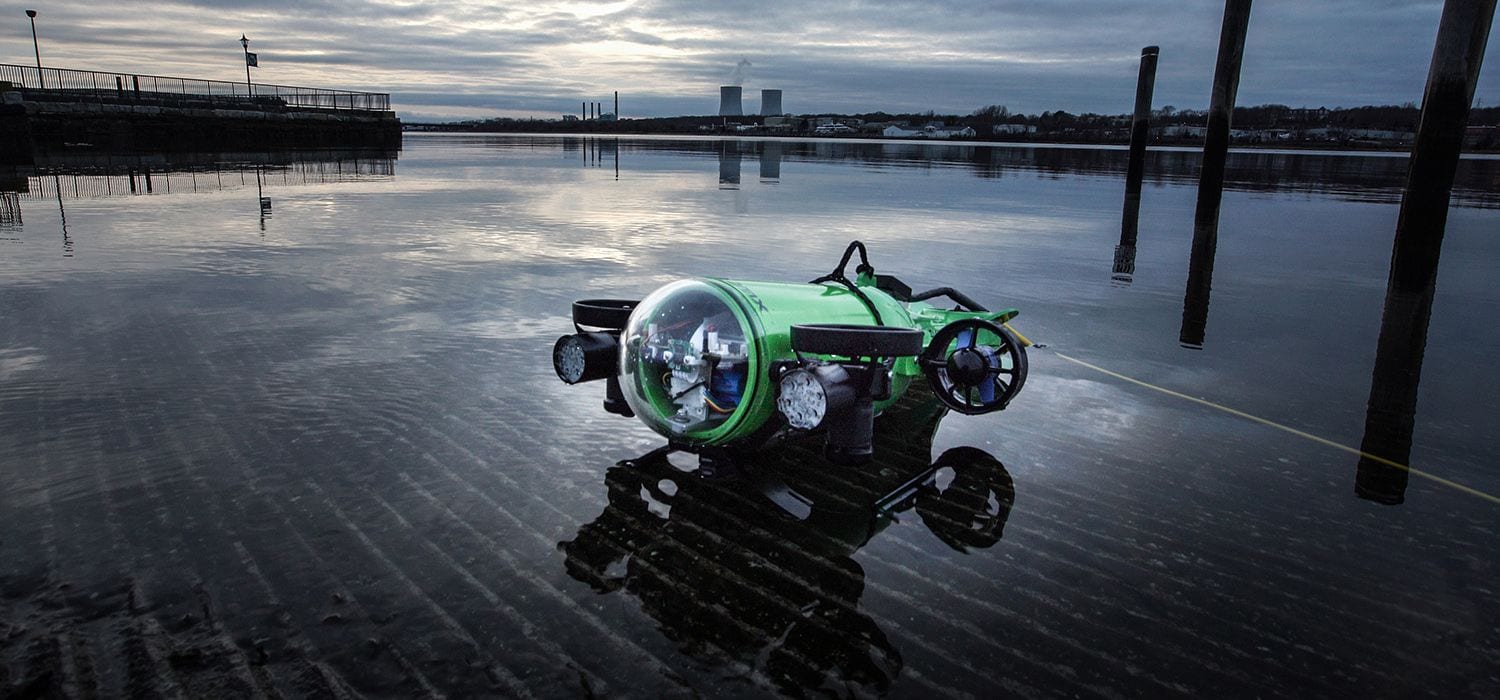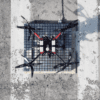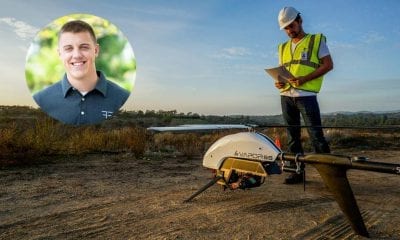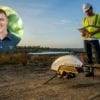
Back to Base (B2B)
An Interview with Durval Tavares, Founder and CTO of Aquabotix
Thanks for joining us Durval. Can you tell us about your professional history and how it has led to the development of Aquabotix?
I founded Aquabotix in 2011 and, until recently, served as CEO of the company. Currently, I serve as Aquabotix’s chief technology officer, leading development of our underwater ROV and hybrid AUV/ROV technology to target such high-demand verticals as military, defense, law enforcement, aquaculture and marine construction and maintenance.

Photo: Aquabotix
Prior to founding the company, I worked at Fidelity Investments for 10 years as a senior executive responsible for leading new product development. Along with earning my BSEE in Electrical Engineering from the University of Massachusetts, I have more than 30 years of experience in technology, defense and finance in both the private and public sectors. I’ve also logged more than 20 years working with underwater technology, including work at the Naval Underwater Warfare Center.
My combined passions for technology, engineering and the ocean led to the creation of Aquabotix, the world’s only publicly traded underwater robotics company. Based in Fall River, Massachusetts, Aquabotix manufactures commercial and industrial-grade underwater drones and underwater cameras for commercial and military applications.
To date, Aquabotix has currently sold more than 380 vehicles in nearly 60 countries worldwide.
Our products are deployed on every continent except Antarctica. In working to catapult our future growth in the Asia-Pacific region, we raised $7 (AUS) million through an initial public offering on the Australian Stock Exchange (ASX).
Early Aquabotix underwater camera technology focussed on tank inspection systems. How has the Aquabotix range grown since your early days?
Given our extensive line of underwater vehicles and underwater AquaLens Connect camera systems, we find that our range of applicable industries where both can be applied has really extended into many different high-demand verticals. For our Endura ROV, for example, we can make great impacts in the fields of aquaculture, energy generation markets, hydrogeneration and oil and gas. Our Hybrid AUV/ROV, the Integra, proves beneficial to users in hydrographic surveying, military and government, environmental monitoring and research. The portability of our vehicles and camera systems, along with their overall ease-of-use, allows for greater user efficiency in exploring underwater, all while reducing both the need for on-site manpower and overall costs.
What challenges are faced in the research and development of aquatic remote operated vehicles (ROVs)?
Probably the biggest challenge we currently face is determining what specific technologies we want to pursue given that this is an extremely wide industry. Our decision-making reflects the value of the marketplace. Taking the market into consideration, we must determine such factors as better automation for infrastructure inspection, or better automation for pipeline tracking. It’s all about seeing what the market dictates relative to the underwater robotics field, and then basing our research and development around those trends. We also need to take the requirements and recommendations of our customers into account in making sure our underwater drones meet their respective business needs.
What makes Aquabotix ROVs unique in the underwater UAV market?
What immediately sets us apart from other underwater robotics companies is that we’re the world’s first publicly-traded underwater drone company. Additionally, we were the first to enable our customers to control ROVs via the iPad.
Our single-person deployable products, including our ROVs, also adhere to an easy-to-use “3-3-3” format: 3 minutes from case to water; 3 hours to basic driver competency; and 3 missions to become an expert without formal training. Additionally, our products feature the most hydrodynamic design on the underwater robotics market today, helping our vehicles not only handle higher currents with greater efficiency, but also be faster – up to five knots of thrust – in the process.
Aquabotix currently offers three product lines for commercial, high-end consumer and military applications. Our portfolio includes Endura remotely operated vehicles (ROVs), Integra Hybrid AUV/ROVs and AquaLens Connect underwater camera systems. Currently, we are one of only a few companies worldwide that offer commercially-available hybrid underwater drones, capable of both autonomous and remote operation.
We have also produced the only digital inspection-class ROV platform that offers live remote viewing and live remote control capabilities. Live Remote Viewing enables real-time underwater viewing and connectivity between Aquabotix’s products and remote customers via the cloud. Live Remote Control, meanwhile, allows users to operate underwater vehicles and cameras remotely from anywhere in the world, using browser-enabled devices that don’t require users to be present on-site. This proves to be a core differentiator between us and other underwater robotics companies in terms of cost and efficiency.
What was Aquabotix’s involvement in the disaster recovery operations for Hurricane Irma? Can you describe any successful outcomes?
Given the substantial amount of damage to offshore and coastal infrastructure in the United States and the Caribbean caused by Hurricanes Harvey and Irma, the overall reconstruction effort will involve a substantial amount of underwater work. In anticipation of this, Aquabotix saw an increased need for its vehicles and undertook a series of initiatives regarding both hurricanes.
The goal was to equip existing and new clients with specialist commercial-grade ROVs required to meet the increased demand for inspection, assessment and recovery activities resulting from damage caused by both hurricanes. We actively engaged with specialist distributors in Florida and the broader Gulf of Mexico region, local and state governments, existing and new U.S. federal customers, including an existing U.S. Coast Guard customer, and existing oil and gas industry customers. We look forward to speaking further with these distributors to see if and how our technology and products best fit their overall needs.
NASA recently purchased an Aquabotix ROV for their Jet Propulsion Laboratory (JPL). Please describe how Aquabotix technology will specifically assist NASA’s Ocean Worlds Exploration Program.
NASA’s Jet Propulsion Laboratory had ordered our Endura 300, a 300-meter depth-rated, commercial-grade ROV integrated with a range of specialist sensors. The agency will use the vehicle in its Ocean Worlds exploration program to create multidimensional maps of oceanic environments. NASA’s Ocean Worlds program is undertaking ocean exploration on Earth to, among other things, assist the agency with its search for the best-known candidates for life in the solar system.
This order is significant because it demonstrates that our products are being utilized by one of the most discerning customers in the world for complicated underwater missions. We look forward to connecting with NASA further to determine how our technology will specifically assist the Ocean Worlds exploration program.
How do you expect the market for underwater drones to grow in the next 5 years?
Further developments in the underwater drone market are proving very similar to advancements that are happening surrounding such other technological innovations as self-driving cars. The true growth area of both markets stems from automation and self-operation. We have already developed technology driven by both automation and self-operation, which puts total vehicle control in the hands of users from anywhere in the world, removing the need for them to actually be on-site monitoring a vehicle underwater.
Additionally, the world’s militaries and defense industry are poised to invest an estimated $3 billion over the next several years to build and field underwater drones for surveillance operations, while addressing increased underwater threats. This would include augmenting and even replacing divers in such hazardous environments as explosive ordinance disposal (EOD), mine countermeasures (MCM), port security and intelligence, surveillance and reconnaissance (ISR).
Where do you envisage the greatest potential for growth in the aquatic UAV market?
As mentioned, the defense sector is gearing up to invest billions in the underwater robotics industry. Other high-demand verticals include security and law enforcement, aquaculture and marine construction and maintenance. Growth will also be seen from the technology side, as cloud-based innovations are developed utilizing the strongest capabilities from automation and self-operation. If you are able to interact with technology anywhere in the world, you have complete control and will see the ultimate results from the vehicles with which you’re working.
What other companies in your space excite or inspire you?
What really excites us at Aquabotix are the innovations developed by companies on the other side of the water – namely aerial drone companies like DJI, which is a leader in that space today. We are also excited by companies advancing developments in cloud technology like Amazon Cloud., as our solutions are very much consistent with what they produce.
Where and what will you be exhibiting next?
We have just introduced our second-generation Integra AUV/ROV for underwater missions. This vehicle is single-person deployable, battery-operated and enables greater cost efficiency for users, as opposed to having to utilize ROVs and AUVs separately for individualized tasks.
The Integra AUV/ROV can be configured with multiple sensors and maneuvered by an easy-to-use intuitive platform accessible from any web-enabled device. The vehicle is designed for use across several sectors, including law enforcement, research, environmental assessment, defense and infrastructure, and can search wide areas using AUV mode (untethered), while conducting detailed inspections using ROV mode (tethered). Users can easily switch from AUV mode to ROV mode by attaching the tether to remotely control the vehicle’s six degrees of freedom of motion. When running the vehicle in autonomous operation, all mission planning is completed in an intuitive Windows-based application.
Our Live Remove Control product feature, as mentioned earlier, allows customers to pilot underwater vehicles and store, analyze and share data remotely, from any web browser-enabled device, anywhere in the world. Aquabotix’s entire family of products, including the Integra, are now equipped with this leading-class functionality.
We particularly look forward to showcasing and discussing these innovations at Underwater Intervention 2018 in New Orleans in February and Oceanology International 2018 in the UK in March.
What will 2018 bring for Aquabotix?
Along with continuing to target high-demand verticals through our products and technology, we are also working to expand our overall operations. We currently have nearly 30 people on our payroll, which is double the size of the company before we put out our IPO.
We’re also pushing forward on the hybrid front. Autonomy is big—connectivity and intelligent behavior and autonomy, the availability of sensors, from low cost to high precision—you’ll see more intelligent behavior, connectivity through cloud computing and better sensors to gather data.
We were very pleased our initial IPO closed substantially oversubscribed at $7 million, and are proud to be the first and only publicly-traded underwater drone company globally. The level of interest in the underwater robotics industry and in Aquabotix shown by institutional and retail investors in Australia and internationally during the IPO validates the six years of work we have invested in catapulting Aquabotix into this industry-leading position.
We are using the money from the public offering to expand our sales, marketing and operations teams. Additionally, we will be using money generated by the IPO to push further into both the military and recreational drone markets and invest in research and development.
Aquabotix is also working on building out an extensive distributor network in the U.S., Australia and elsewhere internationally for the company’s commercial, industrial and military-grade products.
Anything else you’d like to add?
Our vehicles are smart, easy to use and significantly increase the productivity of the team using them. The smart computing power of Aquabotix’s vehicles also enables the company to achieve innovations like Live Remote Control, which is at the forefront of advances in the underwater robotics industry. It used to be that driving an underwater vehicle through a web browser seemed impossible. Live Remote Control now changes how underwater processes can be accomplished on land and under the sea. Meanwhile, our second-generation Integra hybrid vehicle allows users to activate AUV mode for broad range searches, while switching to ROV capabilities for more in-depth analysis of underwater conditions.
Simply put, these innovations are force multipliers for our customers and we are extremely proud to be contributing to the future of underwater robotics.
About Durval Tavares
 Durval Tavares is Chief Technology Officer at Aquabotix, which he founded in 2011. Mr. Tavares has more than 30 years of successful business and entrepreneurial leadership experience in technology, defense and finance organizations in both the private and public sectors. Mr. Tavares has logged more than 20 years working with underwater technology, including AUV, ROV, submarine and torpedo systems development for advanced defense projects and private contractors. His work at the Naval Underwater Warfare Center on submarine technology included several patents in his name. While at Fidelity Investments for 10 years, Mr. Tavares was a senior executive responsible for leading new product development for the financial services giant. Mr. Tavares earned his BSEE in Electrical Engineering from the University of Massachusetts, graduating first in his class. He has made frequent presentations to technical and motivational forums and is active in mentoring programs.
Durval Tavares is Chief Technology Officer at Aquabotix, which he founded in 2011. Mr. Tavares has more than 30 years of successful business and entrepreneurial leadership experience in technology, defense and finance organizations in both the private and public sectors. Mr. Tavares has logged more than 20 years working with underwater technology, including AUV, ROV, submarine and torpedo systems development for advanced defense projects and private contractors. His work at the Naval Underwater Warfare Center on submarine technology included several patents in his name. While at Fidelity Investments for 10 years, Mr. Tavares was a senior executive responsible for leading new product development for the financial services giant. Mr. Tavares earned his BSEE in Electrical Engineering from the University of Massachusetts, graduating first in his class. He has made frequent presentations to technical and motivational forums and is active in mentoring programs.



























